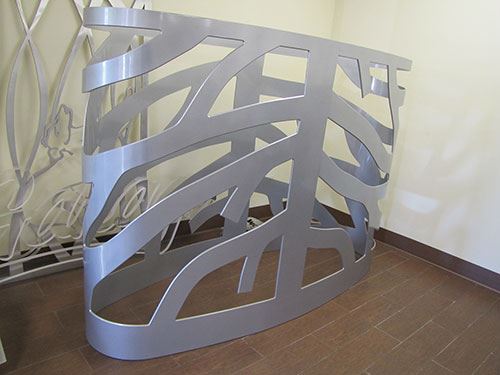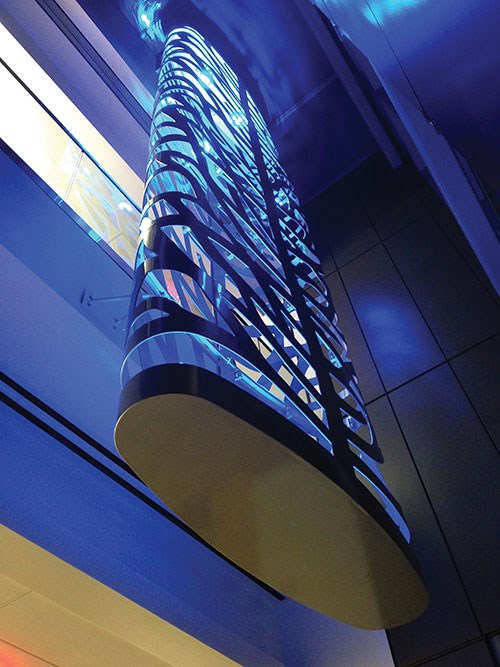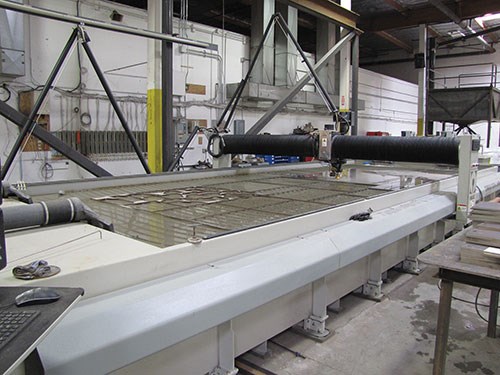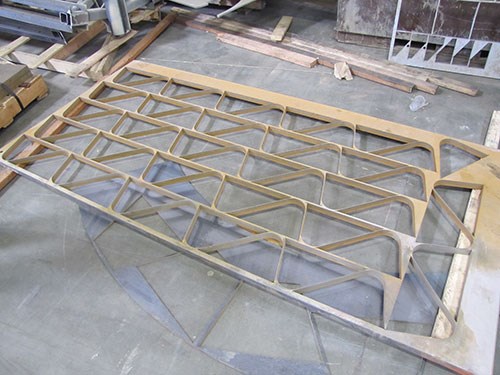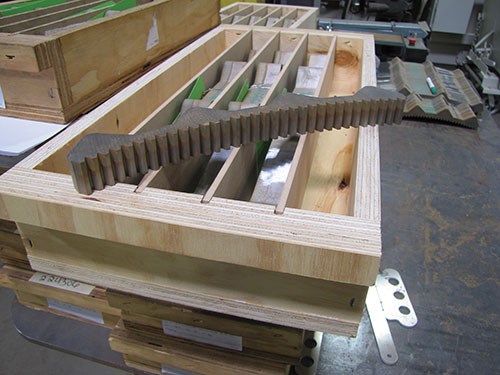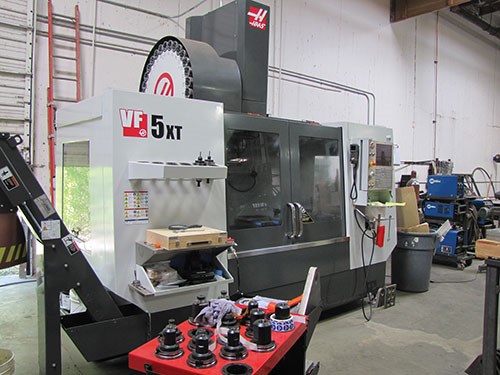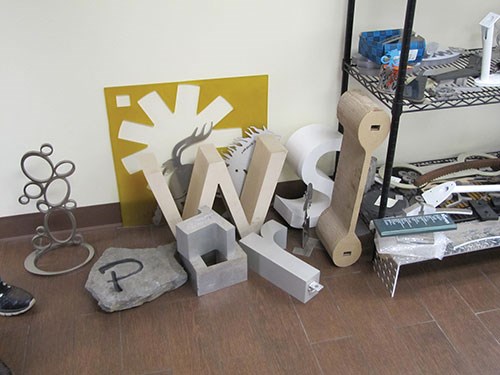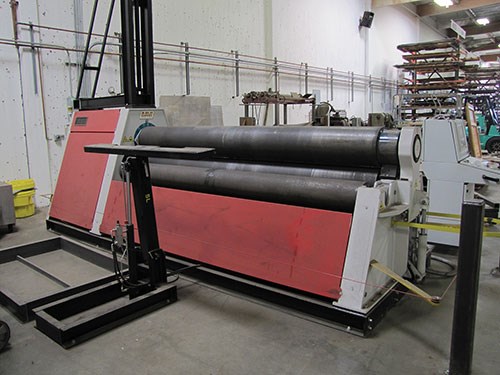Growing the Waterjet Job Shop
The flexibility, capability and precision of the abrasive waterjet cutting process was the perfect match for this entrepreneur’s imagination, drive and boldness.
Share


When the Great Recession of 2008-2009 curtailed Scott Finch’s career as a Seattle-area real estate developer, he needed an outlet for his energy and ambition. For him, this turn of events was not a midlife crisis, but a midlife opportunity—a chance to start over with a new lifestyle and philosophical outlook. He has adopted a new definition of personal success that gives him more satisfaction and contentment, although he admits that he has never been as busy or as focused as he is now.
What made the difference was starting a new business around the abrasive waterjet cutting process. This proved to be the change in direction that Mr. Finch was looking for. Appropriately enough, the current name for this venture is Hydroslice, a job shop dedicated to manufacturing the parts and components that call for the remarkable flexibility and capability of abrasive waterjet technology. “I want the jobs that need the utmost in creativity, resourcefulness and fast turnaround, and that have demanding extremes in size, from the very small to the very large and heavy,” Mr. Finch says.
He likes customers who have to “think outside the box” because their projects are so unusual or wild that customary contractors can’t fulfill the need. Mr. Finch thrives on matching imagination with imagination. As might be expected, some of this work is highly eye-catching and sculptural, such as the illuminated art piece hanging in an entrance hall at a Seattle-area medical college. Other work is thoroughly industrial like the steel gear segments for an aerospace application that require flatness and dimensional accuracy measured in a few thousandths of an inch.
Mr. Finch and his workforce of 15 find the diversity and uniqueness of these jobs to be energizing, yet exacting attention to detail and technical skill keep them grounded. Just as a critical aerospace component can’t be a hairbreadth out of tolerance, even the slightest cosmetic effect on a decorative piece can spoil the intended artistic effect.
Mr. Finch admits that the apparent potential of the abrasive waterjet process was the original inspiration for his enterprise. However, inventing new ways to apply this process is also a key to its success. Complementing waterjet cutting with other manufacturing processes to cut and shape workpieces is a big plus as well. “If I can’t control it, I can’t guarantee it,” he says, citing one of the main reasons Hydroslice has a reputation for getting things done, especially the things other job shops turn down as too difficult.
Having a Blast
Mr. Finch “discovered” abrasive waterjet technology at the Fabtech show in 2009. The collapse of the housing market the year before had impaired his activities in homebuilding and land development. Although this profession seemed suited for his business savvy and boldness as an entrepreneur, this collapse convinced him that a better life lay outside this realm. He was attracted to manufacturing because the assets of production and the tangible worth of part production represented a new sort of ownership that promised more control of his destiny. The prospect of creating wealth by adding value to raw materials also appealed to him. “I needed this change,” Mr. Finch recalls.
At this show, Mr. Finch met Greg Smith, a sales engineer from Omax, a manufacturer of abrasive waterjet equipment headquartered in Kent, Washington. What Mr. Smith showed him was intriguing to Mr. Finch. The flexibility of the process was especially attractive. “I could see the potential for lots of different kinds of part production and many kinds of materials. The process seemed virtually unlimited in many respects, and that appealed to my imagination,” Mr. Finch says. With one machine, he could have a very capable job shop—and that was the ticket to creating a new life as a manufacturer and an entrepreneur. He acquired his first waterjet machine, an Omax 80160, and installed it in a bay of his garage.
Although Mr. Finch did not have a background in engineering or manufacturing, he was confident in his business instincts. “I knew I could be a quick learner, wasn’t afraid to take risks and was committed to success,” he says.
The basics of the waterjet process were easy to grasp. Under high pressure (as much as 60,000 psi), a fine stream of water passes through a nozzle with a very small orifice. The nozzle is positioned by a cutting head in a gantry that rides over a grated bed on which the workpiece lies. The force of the water stream, which strikes the workpiece at very high velocity (higher than twice the speed of sound), is sufficient to penetrate and cut lighter, softer materials such as paper, thin plastics, fiber insulation and such. To cut harder, denser materials, an abrasive powder (usually garnet) is introduced into the stream—hence the term abrasive waterjet cutting. After passing through the workpiece, the force of this abrasive stream quickly dissipates into the pool of water surrounding and covering the bed and workpiece. The only cutting tools involved in the process are water and the abrasive powder. No heat is created to affect material properties of the workpiece, and swarf is almost entirely washed away in the water.
With his first machine, Mr. Finch learned that the process is indeed very capable. However, he quickly realized that skill at finessing the process, making fine adjustments to machine settings and mastering other intricacies made a difference. He also learned the value of having the service and support of Omax as his machine supplier. Maintaining a waterjet machine properly, staying up-to-date with programming techniques, using the latest software releases, troubleshooting and optimizing setups were all lessons this supplier could help with.
Initial success with the first machine put Hydroslice on a steady growth curve. Mr. Finch relocated his shop to larger facilities three times in the next four years, as he expanded by acquiring additional abrasive waterjet machines—about one new machine a year, all of them from Omax. He hired operators, engineers and programmers to nurture this growth, but has always stayed heavily involved as a hands-on manager and doer. Currently, Hydroslice occupies a 30,000 square-foot building near downtown Kent. This facility has a high ceiling and loading docks on the inside and outside. The shop has room for additional machines and equipment at this location.
Most importantly, Mr. Finch says the growth of his business and the expansion of its manufacturing capabilities have validated his dramatic switch of careers. “I’m having a blast,” he says.
Guidelines for Growth
Mr. Finch believes that the growth and success of Hydroslice is based on a number of clear guidelines and principles. The most important are summarized here:
Invest in capacity. This shop has four of the largest abrasive waterjet machines in the area. The largest has a 10-by-30-foot bed, and the ability to handle large, thick plates of steel sets this operation apart. This capacity lends itself to production of large part quantities that can be nested closely on the plate. The scrap web shown to the right attests to this benefit. Large-bed machines enable the shop to set up multiple jobs. Often, one job is running at one end of the bed while another is being set up at the other end. Having multiple cutting heads on three of the machines makes them more productive as well.
Mr. Finch says that Hydroslice never has to pass on a job because its capacity is lacking. If the shop has open space on a table for the work, it will make time to cut it, adding work shifts
as needed.
Invest in capability. Hydroslice makes good use of the advanced features of its waterjet machines. For example, all four of its machines are equipped with an Omax Tilt-A-Jet cutting head. This feature enables them to cut straight edges by automatically compensating for the tendency of the waterjet stream to flare out on tall cuts. Likewise, multi-axis capability for 3D cutting is another example. Three of the shop’s machines have software-controlled multi-axis cutting capability. Cutting beveled edges, angled sides and countersinks has been an essential capability on numerous industrial, as well as decorative, applications.
One prominent industrial example is a contract for aerospace gear segments cut from 1.25-inch thick 4340 steel. The shop cuts 10 different sizes of these segments. Certain features on the gears must have a taper that holds a ± 0.001-inch tolerance. Fixturing this work to hold flatness was a key to success, Mr. Finch notes. (Although waterjet does not subject the workpiece to significant cutting forces, releasing residual stresses while cutting can have an unwanted effect on part quality if it is not controlled by an effective workholding strategy.)
Invest in people. Because the waterjet process is flexible, it naturally attracts a wide variety of workpiece shapes, sizes and materials. A shop’s workforce must therefore be especially resourceful and adaptable. All of Hydroslice’s machine operators can work on any of its four waterjet machines. Most also have additional skills and training to operate one or more of the machines for secondary operations or value-added processes.
The shop also relies on its workforce to respond to rush jobs or customer emergencies. Mr. Finch says he personally shepherds many of these jobs through the shop because this attention reflects his level of commitment. He keeps his own technical training up to date as well. “I never stop learning,” he says.
Hardly ever turn down a job. Because Hydroslice has earned a reputation for getting difficult, high-quality jobs done on time, it is frequently approached for “impossible” jobs. The shop is not afraid to push the limits of its machines and the skills of its workforce to accommodate these requests. This policy pays off in several ways. For one, this work can be profitable because customers are willing to meet premium charges for the service, knowing they will get the quality and promptness that justifies this cost. For another, challenging jobs are great learning exercises. They foster expertise and refine skills, results that carry over to everyday work as well as to the next challenge that comes along.
Adding Processes that Add Value
In addition to the principles for growth mentioned above, Hydroslice has invested in several other processes that add value to customer parts. These include machining, fabricating and welding services. Hydroslice seeks to be a one-stop shop. For customers, this is a benefit because it simplifies procurement and provides single-source responsibility. For the shop, having a variety of secondary processes in-house creates more control over scheduling and quality. It is also a competitive advantage. Providing these processes sets Hydroslice apart from other shops with waterjet capability. Here are more details:
CNC machining. Early in 2015, Hydroslice installed a Haas VF-5XT vertical machining center. In keeping with the shop’s buying practices, this 50-taper, 30-hp machine was chosen for its capacity and capability. It enables the shop to do hole making and hole finishing such as the bearing surfaces inside the brackets shown at right. Another frequent application is profiling edges of thick parts that require a milled surface.
Bending and forming. One of the first non-waterjet machines added to Hydroslice’s equipment roster was a Dener Diamond Elite 20036 press brake. It has a bending length of 144 inches and approximately 230 tons of bending capacity. This press brake enables Hydroslice to supply finished fabrications consisting of components cut with waterjet.
More recently, the shop has installed a large pinch-rolling machine. This Davi MCB 3034 handles plates 10 feet wide and as thick as 3/4 inch. Its main use is to add curvature to flat stock in which a pattern has been cut on a waterjet machine. Drum-shaped parts 20 inches in diameter and 48 inches tall can be produced on this machine. This capability will play a role in a product line that Mr. Finch is developing, although the details of this project have yet to be announced.
Welding. Hydroslice has welding equipment that enables the shop to weld steel, aluminum and some exotic metals. Because high-quality welds are essential to structural integrity as well as cosmetic appearance, skilled welding plays an increasingly important role in many of the shops most conspicuous projects.
3D printing. Hydroslice acquired a MakerBot 3D printer last year. Primarily, it is used to create scale models to help designers evaluate aesthetic designs before full-scale cutting and fabrication is undertaken. Significantly, Mr. Finch sees parallels between industrial applications for additive manufacturing processes and his own experiences with waterjet cutting. The connection is the appeal to the imagination inherent in both processes.
Art and Engineering
One of the aspects of managing a waterjet job shop that renews Mr. Finch’s enthusiasm for the process is its unusual blend of art and engineering. Hydroslice’s customers include artists whose work could not be brought into being without waterjet technology. Artistic creations that use mixed-media—combining components of metal, stone, plastic, wood or rubber—is a specialty for the shop, because all of these materials can be cut with waterjet.
Other customers require the capability of waterjet cutting for highly engineered components such as those for aircraft and aerospace markets. These applications often call for titanium or other aerospace alloys that must avoid thermal damage, contamination with foreign particles or forces that can induce stress inside the part.
Both classes of customers benefit from the capabilities of abrasive waterjet cutting, and waterjet technology relieves many of the constraints that would otherwise hinder innovation and creativity. Mr. Finch sums it up succinctly: “Waterjet is liberating.”
Related Content
Hamar Laser Instruments Surface Plate Calibration System Increases Repeatability
IMTS 2024: Hamar Laser Instruments introduces the L-703SP surface plate calibration system, intended to reduce time for surface plate calibration by 30 to 60%.
Read MoreRobot-Ready Laser Marking Machines Hit the Show Floor
Laser Marking Technologies LLC (LMT) is highlighting its robot readiness not only in its booth but also in its customers’ booths and partners Universal Robots and FANUC booths.
Read MoreMuratec Hybrid Machine Combines Punch Press, Fiber Laser
The MF3048HL combined punch press and fiber laser provides precise cutting, punching, tapping and forming operations on a diverse range of materials.
Read MoreWhere Micro-Laser Machining Is the Focus
A company that was once a consulting firm has become a successful micro-laser machine shop producing complex parts and features that most traditional CNC shops cannot machine.
Read MoreRead Next
OEM Tour Video: Lean Manufacturing for Measurement and Metrology
How can a facility that requires manual work for some long-standing parts be made more efficient? Join us as we look inside The L. S. Starrett Company’s headquarters in Athol, Massachusetts, and see how this long-established OEM is updating its processes.
Read More

